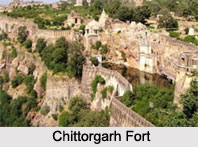 Chittorgarh is a medieval city with a historical significance. This is a medieval city and a municipality in Rajasthan of the north western part of India, where many tourism attractions are located.
Chittorgarh is a medieval city with a historical significance. This is a medieval city and a municipality in Rajasthan of the north western part of India, where many tourism attractions are located.
Location of Chittorgarh
Chittorgarh is situated on the banks of Berach River, a tributary of the rain fed river-Banas River. The city of Chittaurgarh or Chittorgarh has an extension of Gambhir River and Berach River.
History of Chittorgarh
History of Chittorgarh began from the medieval era Rajputana regime. It was named as Chitrakut when Chitrangada Mori, a Rajput head of clan ruled in this area. The fort of Chittorgarh is bounded by a spherical wall. It has seven huge gates to enter the main fort area. Mori Dynasty developed the city with temples and forts. Later, Chittorgarh fell under the hands of Merwar Dynasty. It was a former capital of the Sisodia Rajput Dynasty of Mewar. In 1303, Chittorgarh was captured by Alauddin Khilji, the rule of Delhi Sultanate. Later, it came under the hands of Mughal Dynasty. Chittorgarh witnessed many battles against the Mughals and the Delhi Sultanates till British East India Company came in the limelight.
Geography of Chittorgarh
 Chittorgarh is located at 24.88 degree north to 74.63 degree east. This fortified city has an average elevation of 394 meters from the sea level.
Chittorgarh is located at 24.88 degree north to 74.63 degree east. This fortified city has an average elevation of 394 meters from the sea level.
Education of Chittorgarh
Sainik School, Mewar University, Govt. Sr. Secondary School, Vivekananda Sr. Sec. School, Ujjwal Public School, Bachpan Play School, Maharana Pratap Government Post-Graduation College, Vision School of Management, Mewar Girls Institute of Tech College and many others are the popular educational institutions here.
Administration of Chittorgarh
The modern city of Chittorgarh is the administrative headquarters of Chittorgarh District.
Economy of Chittorgarh
Chittorgarh is dependent of secondary and tertiary industries. Cement Industry, Zinc industry and copper industry are the major holders in Chittorgarh"s economy.
Culture of Chittorgarh
Maharana Pratap Jayanti, Meera Mahotsav, Teej Festival, Gangaur Festival, Jauhar Mela, and Rang Teras are the festivals celebrated in Chittorgarh.
Tourism in Chittorgarh
Chittorgarh Fort, Kalika Mata Temple, Vijay Stambha, Kirti Stambh, Rana Kumbha`s Palace and Rani Padmini Palace are the popular tourism destinations in Chittorgarh.
Visiting Information
Chittorgarh is well connected to all parts of India by roads, rails and the airways. Chittaurgarh Junction is connected with Ajmer, Udaipur, Jaipur, Delhi, Mumbai, Hyderabad, Kolkata, Pune, Yeshwantpur, Ahmadabad, Surat, Indore, Ratlam District, Gwalior, Bhopal, Nagpur, Bilaspur, and Kota. The nearest airport is Udaipur Airport.



















